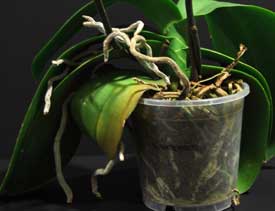
If you've ever wished for a crystal ball, you might already have one, at least where your orchid's health is concerned. An orchid’s leaves can indicate whether your orchid care routine is on the right track or headed in an unhealthy direction.
While other aspects can also indicate the health of your plant, such as its roots, your orchid's leaves are easier to evaluate on a day-to-day basis since they are in plain sight. Here are a few ways your orchid’s leaves can predict the future health of your plant.
Orchids need light to thrive, but too much light is bad news for your orchid. When you place an orchid in direct sunlight it can get sunburned, just like you and me. The leaves will first turn yellow and then white before they eventually die.
The best source of light for orchids is indirect light, so place your orchid near a window facing north or east, and cover the window with a curtain to shield your plant from the intensity of the sun. For west-facing windows, place your orchid farther away from the window.
If you notice your orchid’s leaves are withered and droopy, this could mean your plant is not getting enough water or humidity. An orchid’s natural habitat is a humid, tropical climate, so your plant needs more moisture than a succulent, which thrives in the desert.
On the flip side, limp and leathery leaves could mean that the root system is having a hard time supplying the leaves with hydration. Root rot is a common problem that can lead to these symptoms. Many orchid owners don't realize that root rot is most often caused by overwatering, not underwatering!
If your potting media seems wet most of the time instead of dry, this might be your problem instead of dehydration. Limp and leathery leaves that are caused by root rot are sometimes accompanied by black discoloration.
Pro Tip: Want an easy way to give your orchid just the right amount of water? Water it with three ice cubes once a week. Depending on where you live, you may need to increase the amount of water or humidity around your orchid during the winter.
Black leaves can indicate bacterial or fungal growth, or even too much fertilizing or mineral deposits from hard water. You can combat this by cutting away at the blackened portions with sterile scissors and incorporating antifungal and antibacterial remedies into your orchid care.
Brown streaks on your orchid’s leaves may indicate your orchid has come down with a disease, which could be bacterial, fungal or even viral in nature. If you notice brown streaks on your orchid’s leaves, the best course of action is to quarantine your plant until you know the exact problem. The best strategy is to prevent illness from even happening through good orchid care practices.
Pro tip: Use sterilized tools, such as scissors, when trimming orchid spikes.
Want to learn more about how to read your orchid's leaves to keep it healthy? Download our Orchid Health Leaf Guide.

Copyright Just Add Ice® Orchids 2023